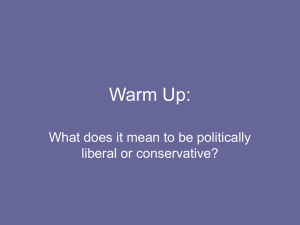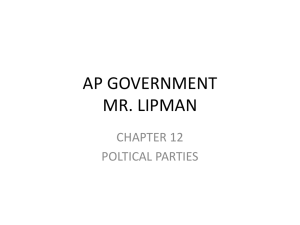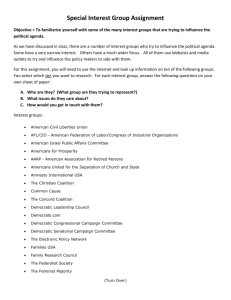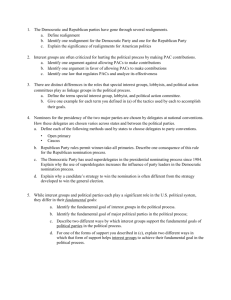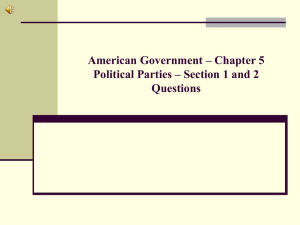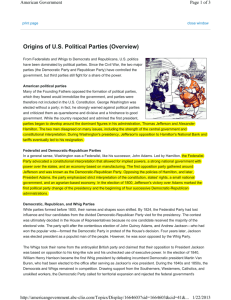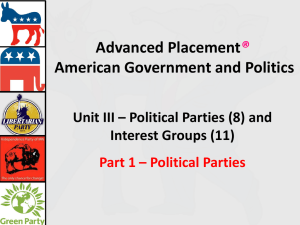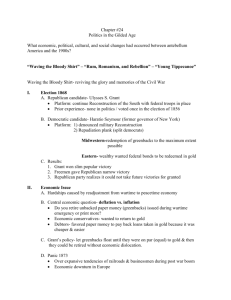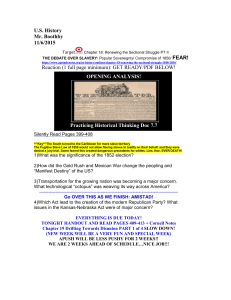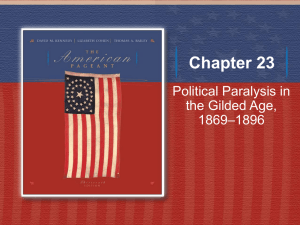lesson 3 - The New York Times
advertisement
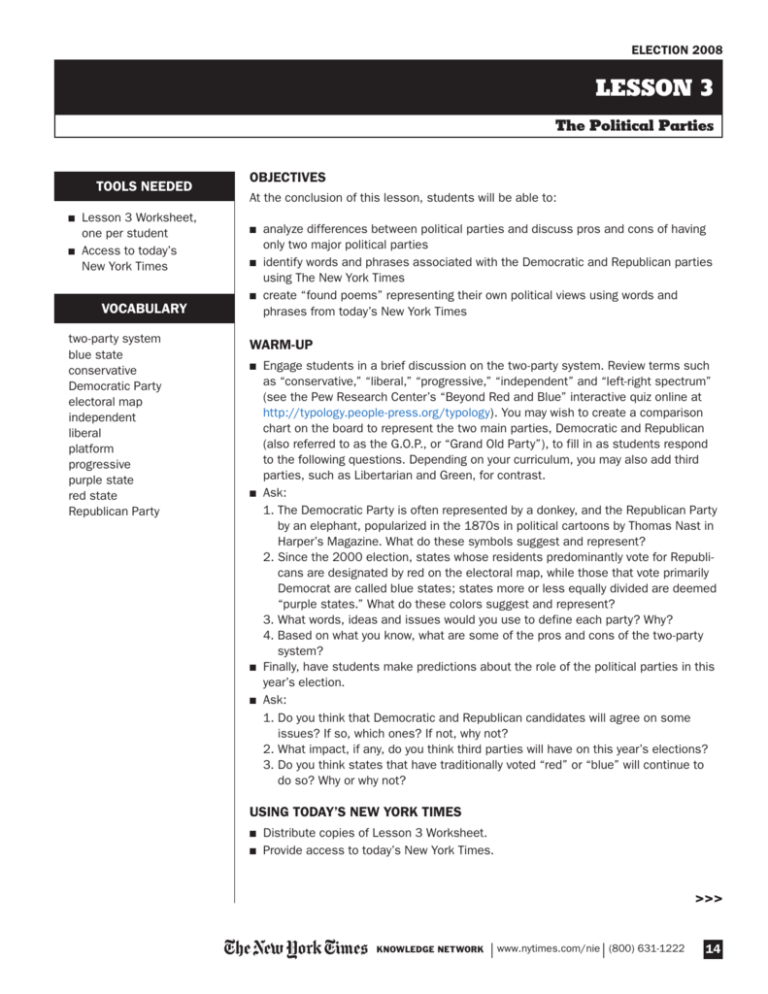
ELECTION 2008 LESSON 3 The Political Parties TOOLS NEEDED ■ ■ L esson 3 Worksheet, one per student Access to today’s New York Times VOCABULARY two-party system blue state conservative Democratic Party electoral map independent liberal platform progressive purple state red state Republican Party OBJECTIVES At the conclusion of this lesson, students will be able to: ■ ■ ■ nalyze differences between political parties and discuss pros and cons of having a only two major political parties identify words and phrases associated with the Democratic and Republican parties using The New York Times create “found poems” representing their own political views using words and phrases from today’s New York Times WARM-UP ■ ■ ■ ■ ngage students in a brief discussion on the two-party system. Review terms such E as “conservative,” “liberal,” “progressive,” “independent” and “left-right spectrum” (see the Pew Research Center’s “Beyond Red and Blue” interactive quiz online at http://typology.people-press.org/typology). You may wish to create a comparison chart on the board to represent the two main parties, Democratic and Republican (also referred to as the G.O.P., or “Grand Old Party”), to fill in as students respond to the following questions. Depending on your curriculum, you may also add third parties, such as Libertarian and Green, for contrast. Ask: 1. The Democratic Party is often represented by a donkey, and the Republican Party by an elephant, popularized in the 1870s in political cartoons by Thomas Nast in Harper’s Magazine. What do these symbols suggest and represent? 2. Since the 2000 election, states whose residents predominantly vote for Republicans are designated by red on the electoral map, while those that vote primarily Democrat are called blue states; states more or less equally divided are deemed “purple states.” What do these colors suggest and represent? 3. What words, ideas and issues would you use to define each party? Why? 4. Based on what you know, what are some of the pros and cons of the two-party system? Finally, have students make predictions about the role of the political parties in this year’s election. Ask: 1. Do you think that Democratic and Republican candidates will agree on some issues? If so, which ones? If not, why not? 2. What impact, if any, do you think third parties will have on this year’s elections? 3. Do you think states that have traditionally voted “red” or “blue” will continue to do so? Why or why not? USING TODAY’S NEW YORK TIMES ■ ■ Distribute copies of Lesson 3 Worksheet. Provide access to today’s New York Times. >>> -019.'&)'0'6914-019.'&)'0'6914- | www.nytimes.com/nie | (800) 631-1222 14 ELECTION 2008 LESSON 3 The Political Parties T o go beyond today’s news, provide students with access to or resources from The New York Times Election Guide 2008 (http://politics.nytimes.com/electionguide/2008/index.html) and The Caucus, The New York Times political blog (http://thecaucus.blogs.nytimes.com). ■ Ask: 1. What words and phrases can you find in the articles in today’s New York Times to represent the positions and perspectives of the Democratic and Republican parties? 2. After students have completed their worksheets, have them reconvene to discuss their findings. Be sure to clarify any misconceptions regarding Democratic, Republican or other perspectives and positions. ■ HOMEWORK ■ ■ F or homework, have students create “found poems” to represent their own political points of view, using the words and phrases compiled for Worksheet #2. A “found poem” is one in which words and phrases are taken from various sources and juxtaposed to create new meaning. For an example of a found poem, see Read Write Think’s “Found and Parallel Poems” (http://www.readwritethink.org/lesson_ images/lesson33/foundparallelpoems.pdf). In a subsequent class period, have students read their poems in groups and challenge other students to guess with which political party or beliefs they identify. EXTENSIONS ■ T o make this assignment more challenging, have students write a “stump,” or campaign, speech for a candidate using the words and phrases they compiled on their worksheets. Encourage students to visit The New York Times Election Guide 2008 (http://politics.nytimes.com/election-guide/2008/election/index.html) for further information on the candidates and issues. ■ istribute blank maps of the United States to students and have them color in red D or blue as the election results are announced. For further classroom election activity ideas, see The New York Times Learning Network Issues in Depth: Election 2008 (http://www.nytimes.com/learning/issues_in_depth/20080204.html). ■ hat is the historical basis for our two-party system? Have students explore the W original debate between Federalists and Anti-Federalists, and then create a timeline of American political parties from 1789 to the present. ■ ave the class research and create a guide to current third parties in the United H States. They may organize parties by categories, such as ideology, single-issue, economic protest and splinter group. For a comprehensive source of national and regional third party platforms and candidates online, visit 3PC.net (http://www.3pc. net/parties.html). ■ ow are the Democratic and Republican parties using the Web? Have students H visit both parties’ official Web sites at http://www.democrats.org and >>> -019.'&)'0'6914-019.'&)'0'6914- | www.nytimes.com/nie | (800) 631-1222 15 ELECTION 2008 LESSON 3 The Political Parties http://www.rnc.org, as well as the campaign sites of the two main presidential candidates, and write report cards evaluating each party’s and candidate’s use of Internet technology. How sophisticated is each site? Who are they trying to reach? To whom do you think their Web site will most likely appeal, and why? What image are they trying to project for the party (or candidate)? How successful are they in their efforts? What improvements might they make to appeal to certain demographics? ■ ave students work in groups to create their own political parties, including an H ideas/issues platform, symbol, campaign slogan, and even a convention speech. -019.'&)'0'6914-019.'&)'0'6914- | www.nytimes.com/nie | (800) 631-1222 16 ELECTION 2008 Student Activity Sheet Comparing Political Party Platforms LESSON 3: The Political Parties Name______________________________________________________________DATE_____________________________ On the diagram below, fill in the circles with words and phrases that represent Democratic, Republican and other (either independent or third party) perspectives and positions, as expressed by members of those parties, from today’s New York Times articles. Note the page number next to each word or phrase. Democratic Republican Other -019.'&)'0'6914-019.'&)'0'6914- | www.nytimes.com/nie | (800) 631-1222 17
